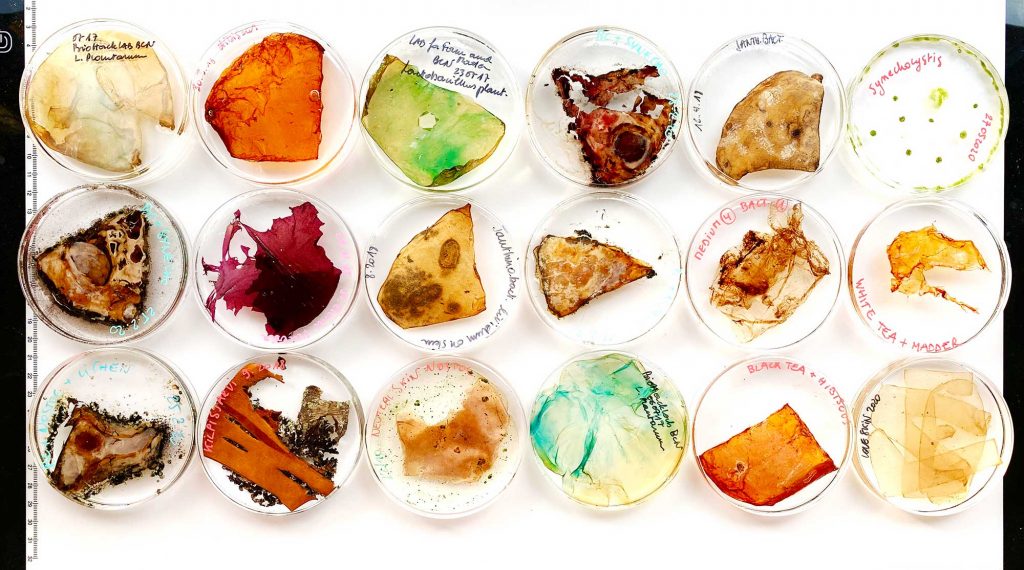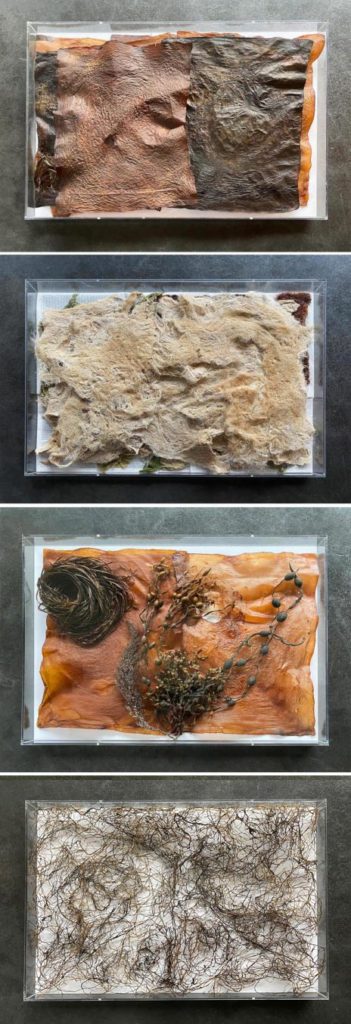The scientific research of the project Sensorial Skin [for an Intelligent Beehive] focuses on turning the skin into a biosensor. I believe that working with cyanobacteria is a promising path to achieve the objectives regarding the responsive skin, because cyanobacteria are auto-trophe and they can live in colonies and react as such. They are able to obtain energy through photosynthesis (a process which converts light energy into chemical energy which can be transformed into electrical energy) and because they can change their internal (and hence external) state based on the degrees of atmospheric pollution that causes them stress. Therefore, I started to study a selection of cyanobacteria species at the Hybrid Forms Lab. I followed a preconceived outline of scientific and artistic procedures.
Important steps in my scientific research were: (1) the choice which bacteria species are used as the basis for photosynthesis, (2) the choice of the growth medium for the bacteria, (3) the choice of the exoskeleton, (4) the mechanisms for converting the captured energy into electrical energy, and (5) the environmental properties that can be sensed directly by the cover shield.

A series of tests run in the Hybrid Forms Lab (VU Amsterdam) and at the Open BioLab Brussels – 2019/2020
(1) LICHEN RESEARCH in the Hybrid Forms Lab
Besides cyanobacteria, the Sensorial Skin project studies the possibility to work with other organisms for sensing the environment. One of these organisms that is worth exploring is lichen. In this context, I especially want to research the mutualistic relation between cyanobacteria and lichen growing as a Sensorial Skin around the beehive. Lichen, a symbiotic cohabitation of cyanobacteria and fungi, is a composite organism that emerges from cyanobacteria living among the filaments of the fungi in a mutually beneficial symbiotic relationship. The fungi benefit from the carbohydrates produced by the cyanobacteria via photosynthesis, and the cyanobacteria assure their need for a humid environment through the proximity of the fungi. This cohabitation and collaboration is intriguing. Lichen reacts to sulphur dioxide and acid rain, ozone and nitrogen compounds, fluorides (a side effect of aluminium and glass making and production of fertilisers), toxic aromatic hydrocarbons, metals, and radioactive elements. The effects of these reactions are visible through changes in colour or texture of the lichen and could therefore potentially be used. Lichen can be integrated in the exoskeleton or in the medium. I will do fieldwork to collect samples of lichen and cyanobacteria in wet environments in and around Amsterdam and take them for in-depth study into the lab. In the wet lab of the Hybrid Form Lab I will study the samples and grow the lichen with a variety of micro-algae/cyanobacteria on different growth mediums. The goal is to work very closely with the scientists in the Hybrid Forms lab.
(2) CYANOBACTERIA / micro ALGAE RESEARCH with other partners
The Sensorial Skin project will continue to study a range of possibilities to visualise the pollution in our environment and to raise awareness. An important factor that is not yet studied in-depth, is to define which gasses, carbon or fine dust particles or other chemical substances that can be sensed by our bacterial biosensor. Therefore, I will set up a research project in a collaborative framework with partners specialised in at the one hand cyanobacteria and at the other hand synthetic biology.
More information in the report:
STARTS Residency, Public Report ‘Sensorial Skin’

